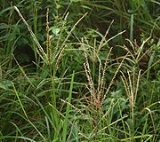
Eleusine indica
Encyclopedia
Eleusine indica is an invasive species
in the grass family Poaceae
. It is a small annual weed distributed throughout the warmer areas of the world to about 50 degrees latitude. Understanding this species is complicated by disagreement about species limits, and by persistent misspelling.
The correct spelling of the genus
is Eleusine, but much of the popular literature spells it Elusine.
Eleusine indica is closely related to Eleusine coracana (L.) Gaertn. (Finger Millet
, Ragi, Poor Man’s Millet). In fact, diploid E. indica is one of the ancestors of allotetraploid E. coracana. If the little weed and the crop are considered to be a single species, then it is appropriate to say that the scientific name for Ragi is E. indica, but botanists now prefer to treat them as two different species. In that case, the correct name for Ragi
is E. coracana, not E. indica. In this article, the name E. indica is limited to the diploid weed.
Seeds of E. indica are edible and are sometimes used in starvation situations, but yields are low. In addition, the ability of weedy E. indica to live in trampled, contaminated soils increases the risk that its seeds may contain undesirable chemicals.
Eleusine indica is an important weed in cultivated crops, lawns, and golf courses. It thrives in disturbed areas with compacted soils in full sun. Both tillage and herbicides are used in its control. This low-growing grass is capable of setting seed even when closely mowed. Some populations have evolved resistance to certain herbicide
s, including glyphosphate.
Eleusine indica performs C4 photosynthesis and therefore can grow in hot climates and in the hotter months of the temperate zone. Its seeds germinate later in spring than most temperate zone grasses that are weeds in the same sites, such as crabgrasses. Though usually considered an annual, it may survive for more than a year in climates not subject to frost.
Invasive species
"Invasive species", or invasive exotics, is a nomenclature term and categorization phrase used for flora and fauna, and for specific restoration-preservation processes in native habitats, with several definitions....
in the grass family Poaceae
Poaceae
The Poaceae is a large and nearly ubiquitous family of flowering plants. Members of this family are commonly called grasses, although the term "grass" is also applied to plants that are not in the Poaceae lineage, including the rushes and sedges...
. It is a small annual weed distributed throughout the warmer areas of the world to about 50 degrees latitude. Understanding this species is complicated by disagreement about species limits, and by persistent misspelling.
The correct spelling of the genus
Genus
In biology, a genus is a low-level taxonomic rank used in the biological classification of living and fossil organisms, which is an example of definition by genus and differentia...
is Eleusine, but much of the popular literature spells it Elusine.
Eleusine indica is closely related to Eleusine coracana (L.) Gaertn. (Finger Millet
Finger millet
Eleusine coracana, commonly Finger millet , also known as African millet or Ragi is an annual plant widely grown as a cereal in the arid areas of Africa and Asia. E...
, Ragi, Poor Man’s Millet). In fact, diploid E. indica is one of the ancestors of allotetraploid E. coracana. If the little weed and the crop are considered to be a single species, then it is appropriate to say that the scientific name for Ragi is E. indica, but botanists now prefer to treat them as two different species. In that case, the correct name for Ragi
Finger millet
Eleusine coracana, commonly Finger millet , also known as African millet or Ragi is an annual plant widely grown as a cereal in the arid areas of Africa and Asia. E...
is E. coracana, not E. indica. In this article, the name E. indica is limited to the diploid weed.
Seeds of E. indica are edible and are sometimes used in starvation situations, but yields are low. In addition, the ability of weedy E. indica to live in trampled, contaminated soils increases the risk that its seeds may contain undesirable chemicals.
Eleusine indica is an important weed in cultivated crops, lawns, and golf courses. It thrives in disturbed areas with compacted soils in full sun. Both tillage and herbicides are used in its control. This low-growing grass is capable of setting seed even when closely mowed. Some populations have evolved resistance to certain herbicide
Herbicide
Herbicides, also commonly known as weedkillers, are pesticides used to kill unwanted plants. Selective herbicides kill specific targets while leaving the desired crop relatively unharmed. Some of these act by interfering with the growth of the weed and are often synthetic "imitations" of plant...
s, including glyphosphate.
Eleusine indica performs C4 photosynthesis and therefore can grow in hot climates and in the hotter months of the temperate zone. Its seeds germinate later in spring than most temperate zone grasses that are weeds in the same sites, such as crabgrasses. Though usually considered an annual, it may survive for more than a year in climates not subject to frost.

